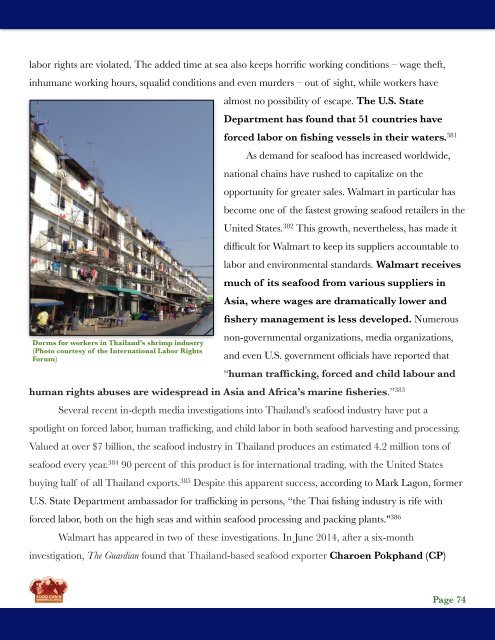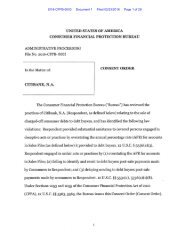Walmart-at-the-Crossroads-FINAL-06.04.15
Walmart-at-the-Crossroads-FINAL-06.04.15
Walmart-at-the-Crossroads-FINAL-06.04.15
Create successful ePaper yourself
Turn your PDF publications into a flip-book with our unique Google optimized e-Paper software.
labor rights are viol<strong>at</strong>ed. The added time <strong>at</strong> sea also keeps horrific working conditions – wage <strong>the</strong>ft,<br />
inhumane working hours, squalid conditions and even murders – out of sight, while workers have<br />
Dorms for workers in Thailand’s shrimp industry<br />
(Photo courtesy of <strong>the</strong> Intern<strong>at</strong>ional Labor Rights<br />
Forum)<br />
almost no possibility of escape. The U.S. St<strong>at</strong>e<br />
Department has found th<strong>at</strong> 51 countries have<br />
forced labor on fishing vessels in <strong>the</strong>ir w<strong>at</strong>ers.<br />
381<br />
As demand for seafood has increased worldwide,<br />
n<strong>at</strong>ional chains have rushed to capitalize on <strong>the</strong><br />
opportunity for gre<strong>at</strong>er sales. <strong>Walmart</strong> in particular has<br />
become one of <strong>the</strong> fastest growing seafood retailers in <strong>the</strong><br />
United St<strong>at</strong>es.<br />
382<br />
This growth, never<strong>the</strong>less, has made it<br />
difficult for <strong>Walmart</strong> to keep its suppliers accountable to<br />
labor and environmental standards. <strong>Walmart</strong> receives<br />
much of its seafood from various suppliers in<br />
Asia, where wages are dram<strong>at</strong>ically lower and<br />
fishery management is less developed. Numerous<br />
non-governmental organiz<strong>at</strong>ions, media organiz<strong>at</strong>ions,<br />
and even U.S. government officials have reported th<strong>at</strong><br />
“human trafficking, forced and child labour and<br />
human rights abuses are widespread in Asia and Africa’s marine fisheries.”<br />
383<br />
Several recent in-depth media investig<strong>at</strong>ions into Thailand’s seafood industry have put a<br />
spotlight on forced labor, human trafficking, and child labor in both seafood harvesting and processing.<br />
Valued <strong>at</strong> over $7 billion, <strong>the</strong> seafood industry in Thailand produces an estim<strong>at</strong>ed 4.2 million tons of<br />
seafood every year.<br />
384<br />
90 percent of this product is for intern<strong>at</strong>ional trading, with <strong>the</strong> United St<strong>at</strong>es<br />
buying half of all Thailand exports.<br />
385<br />
Despite this apparent success, according to Mark Lagon, former<br />
U.S. St<strong>at</strong>e Department ambassador for trafficking in persons, “<strong>the</strong> Thai fishing industry is rife with<br />
forced labor, both on <strong>the</strong> high seas and within seafood processing and packing plants."<br />
386<br />
<strong>Walmart</strong> has appeared in two of <strong>the</strong>se investig<strong>at</strong>ions. In June 2014, after a six-month<br />
investig<strong>at</strong>ion, The Guardian found th<strong>at</strong> Thailand-based seafood exporter Charoen Pokphand (CP)<br />
Page !74



